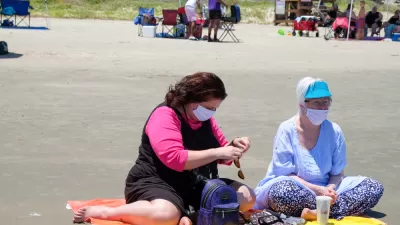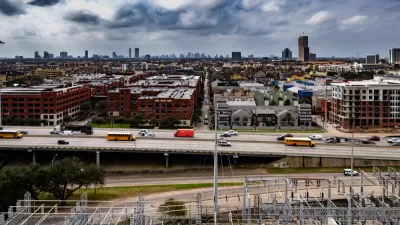Using the Urban Institute's Mapping America's Futures tool, the Kinder Institute overviews likely racial demographics in Texas and elsewhere by 2030.

A piece from Rice University's Kinder Institute for Urban Research looks at potential demographic futures in Houston and elsewhere. Its tool of choice: the Urban Institute's interactive Mapping America's Futures interface. Leah Binkovitz writes: "Assuming an average birth rate, death rate and average migration rate, the Houston area is expected to add roughly 2.2 million people between 2010 and 2030. That's a 37.68 percent increase. The area's white population appears pretty flat in this scenario, while the Hispanic population rises steadily above 3 million by 2030."
Under the same parameters, more modest growth is expected from Dallas and Fort Worth, while San Antonio may see a 33.4 percent population increase. Austin's growth may be steeper still, at 46.93 percent. "Outside Texas, Las Vegas, Phoenix, Orlando and Raleigh all showed large projected increases."
On the national level, Hispanic population is set to increase at a rapid clip through 2030. In Houston, the racial group denoted "Other, which refers here to any non-Hispanic, non-white and non-black groups, including American Indians, Asian, Pacific Islanders and other groups," will also see significant growth from relatively low starting numbers. "Under average rate assumptions, that population would grow 117.26 percent between 2010 and 2030, according to the Urban Institute."
FULL STORY: Projections Show How Houston, and the Country, Will Change By 2030

Planetizen Federal Action Tracker
A weekly monitor of how Trump’s orders and actions are impacting planners and planning in America.

Chicago’s Ghost Rails
Just beneath the surface of the modern city lie the remnants of its expansive early 20th-century streetcar system.

San Antonio and Austin are Fusing Into one Massive Megaregion
The region spanning the two central Texas cities is growing fast, posing challenges for local infrastructure and water supplies.

Since Zion's Shuttles Went Electric “The Smog is Gone”
Visitors to Zion National Park can enjoy the canyon via the nation’s first fully electric park shuttle system.

Trump Distributing DOT Safety Funds at 1/10 Rate of Biden
Funds for Safe Streets and other transportation safety and equity programs are being held up by administrative reviews and conflicts with the Trump administration’s priorities.

German Cities Subsidize Taxis for Women Amid Wave of Violence
Free or low-cost taxi rides can help women navigate cities more safely, but critics say the programs don't address the root causes of violence against women.
Urban Design for Planners 1: Software Tools
This six-course series explores essential urban design concepts using open source software and equips planners with the tools they need to participate fully in the urban design process.
Planning for Universal Design
Learn the tools for implementing Universal Design in planning regulations.
planning NEXT
Appalachian Highlands Housing Partners
Mpact (founded as Rail~Volution)
City of Camden Redevelopment Agency
City of Astoria
City of Portland
City of Laramie




























